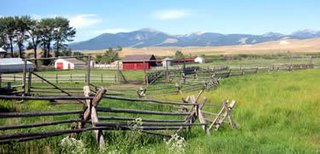This article needs additional citations for verification .(October 2017) |
A ranch school is a type of school used in rural areas of the Western United States. [1]
This article needs additional citations for verification .(October 2017) |
A ranch school is a type of school used in rural areas of the Western United States. [1]
The ranch school movement began in the Western United States in the early 1900s as a way to educate children who lived on ranches in remote and rural areas, far away from regular schools in the towns and cities. The idea was popular and within a short time many ranch schools took on characteristics of a boarding school and a dude ranch, where Easterners or city-dwellers could send their children as well. [1]
At the time, Americans widely believed that the arid climate of the Western states could help children recuperate from conditions like asthma. The hard work that went with living and working on a ranch and spending a lot of time outdoors was also appealing to those who wanted their children to grow up strong, healthy and independent. Most ranch school students rode a horse every day and were taught the basics of ranching and living outdoors, in addition to regular school teachings. [1] [2]
Arizona led the nation in the number of ranch schools, most of which were in the Tucson area. Many were for boys only, but there were some all-girls schools as well, such as the Hacienda del Sol school outside of Tucson or the Jokake School in Scottsdale. Most of the ranch schools were built for locals, but some ranchers — such as those at the Little Outfit Ranch in Arizona's San Rafael Valley — established ranches with the specific intention of operating them as boarding schools for "city boys". [1] [2]
Ranch schools were advertised in magazines and newspapers, drawing in students and their families from across the country, and as a result are credited with contributing to the growth of the tourism industry in the Southwest in the early 1900s. By the 1960s, most of the ranch schools in the United States were closed or soon-to-be closed, marking the end of the traditional ranch school movement. [1] However, some ranch schools have survived, such as Deep Springs College.
Many contemporary ranch schools are therapeutic boarding schools for "troubled teens".

Casas Adobes is an unincorporated community and census-designated place (CDP) located in the northern metropolitan area of Tucson, Arizona. The population was 66,795 at the 2010 census. Casas Adobes is situated south and southwest of the town of Oro Valley, and west of the community of Catalina Foothills.

Catalina Foothills is an unincorporated community and census-designated place (CDP) located north of Tucson in Pima County, Arizona, United States. Situated in the southern foothills of the Santa Catalina Mountains, Catalina Foothills had a population of 50,796 at the 2010 census. Catalina Foothills is one of the most affluent communities in Arizona and in the U.S., with the 6th highest per capita income in Arizona, and the 14th highest per capita income in the U.S. of communities with a population of at least 50,000. The Catalina Foothills community includes some of Arizona's most expensive homes and land, and has the highest median property value. It also includes resorts, golf courses, and spas.

Oro Valley, incorporated in 1974, is a suburban town located 6 miles (9.7 km) north of Tucson, Arizona, United States, in Pima County. According to the 2020 census, the population of the town is 47,070, an increase from 29,700 in 2000. Dubbed the "Upscale Tech Mecca" of Southern Arizona by the Arizona Daily Star newspaper, Oro Valley is home to over 10 high tech firms and has a median household income nearly 50% higher than the U.S. median. The town is located approximately 110 miles (180 km) southeast of the state capital of Phoenix.

Tanque Verde is a suburban unincorporated community in Pima County, Arizona, United States, northeast of Tucson. The population was 16,195 at the 2000 census. For statistical purposes, the United States Census Bureau has defined Tanque Verde as a census-designated place (CDP).
A guest ranch, also known as a dude ranch, is a type of ranch oriented towards visitors or tourism. It is considered a form of agritourism.

The Santa Catalina Mountains, commonly referred to as the Catalina Mountains or the Catalinas, are north and northeast of Tucson in Arizona, United States, on Tucson's north perimeter. The mountain range is the most prominent in the Tucson area, with the highest average elevation. The highest point in the Catalinas is Mount Lemmon at an elevation of 9,157 feet (2,791 m) above sea level and receives 18 inches (46 cm) of precipitation annually.

One-room schools, or schoolhouses, were commonplace throughout rural portions of various countries, including Prussia, Norway, Sweden, the United States, Canada, Australia, New Zealand, the United Kingdom, Ireland, and Spain. In most rural and small town schools, all of the students met in a single room. There, a single teacher taught academic basics to several grade levels of elementary-age children. While in many areas one-room schools are no longer used, some remain in developing nations and rural or remote areas.

Amphitheater Public Schools, also known as Amphi or District 10, is the third largest public school district in Tucson, Arizona, in terms of enrollment, with about 13,500 students and a staff of about 2000 employees Amphi was established on July 3, 1893. With its headquarters in Flowing Wells, presently serves segments of North Tucson, Casas Adobes, Catalina Foothills, and the communities of Oro Valley, eastern Tortolita, and Catalina northwest of the city.

Arivaca is an unincorporated community in Pima County, Arizona, United States. It is located 11 miles (18 km) north of the Mexican border and 35 miles (56 km) northwest of the port of entry at Nogales. The European-American history of the area dates back at least to 1695, although the community was not founded until 1878. Arivaca has the ZIP code 85601. The 85601 ZIP Code Tabulation Area had a population of 909 at the 2000 census.
Tres Alamos is a ghost town in Cochise County in the U.S. state of Arizona. The town was settled in 1874 in what was then the Arizona Territory.
Redington is a populated place in Pima County, Arizona, United States.

Eulalia "Sister" Bourne was a pioneer Arizona schoolteacher, rancher and writer. She taught at rural Arizona schools from 1914 to 1957.

The Little Outfit Schoolhouse is a ranch school that was built in 1940 in southeastern Arizona. It is located on the Little Outfit Ranch in San Rafael Valley, about ten miles east-southeast of Patagonia, in Santa Cruz County, which borders Mexico on the south and is about 80 miles from Arizona's eastern border with New Mexico.

A ranch is an area of land, including various structures, given primarily to ranching, the practice of raising grazing livestock such as cattle and sheep. It is a subtype of a farm. These terms are most often applied to livestock-raising operations in Mexico, the Western United States and Western Canada, though there are ranches in other areas. People who own or operate a ranch are called ranchers, cattlemen, or stockgrowers. Ranching is also a method used to raise less common livestock such as horses, elk, American bison, ostrich, emu, and alpaca.

Aztec Land and Cattle Company, Limited ("Aztec") is a land company with a historic presence in Arizona. It was formed in 1884 and incorporated in early 1885 as a cattle ranching operation that purchased 1,000,000 acres in northern Arizona from the Atlantic & Pacific Railroad. It then imported approximately 32,000 head of cattle from Texas and commenced ranching operations in Arizona. Because Aztec's brand was the Hashknife, a saddler's knife used on early day ranches, the company was known more famously as The Hashknife Outfit. The company has been in continuous existence since 1884.

The Little Red Schoolhouse is a historic one-room schoolhouse located a few miles northeast of Nogales, Arizona, in the community of Beyerville. Opened in 1921 to serve the children of local farmers and ranchers, the Little Red Schoolhouse is the only one remaining of approximately two dozen red schoolhouses built in the Santa Cruz River valley in the 1920s.
The White Stallion Ranch, in Pima County, Arizona near Tucson, is a historic guest ranch. It is one of only two surviving dude ranches of the Tucson area, where there once were 20 or so.
Hacienda Del Sol Guest Ranch Resort is a hotel in the Catalina Foothills section of Tucson, Arizona. It began in 1929 as a private boarding school for girls. It was converted into a guest ranch after World War II.